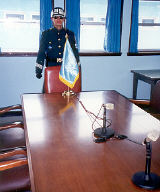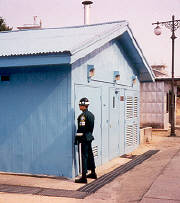The Korean DMZ: A Propaganda Playground
Korea
Embittered taxi drivers honking their horns and the distinct waft of kimchi seeping under my door had become my alarm clock every morning while teaching English in Seoul, South Korea. Today was no different as I slowly got up and made my way to the shower. It was not going to be like most days where I went to class and taught the intricacies of the word ‘cool’. No, today I would be the student. Today I was headed to the Demilitarized Zone (DMZ) of North and South Korea. Today I hoped to gain more insight and a better understanding of the people and customs of Korea.
I quickly realized this was going to be tougher than I thought, as I boarded a bus full of white faces in GAP-inspired attire, speaking English at supersonic speeds. After one and a half years immersed in Korean life, this was more of a culture shock than any stern-faced North Korean soldier with a machine gun would ever be. The passengers on board were comprised mostly of US expats and their families. I appeared to be the sole Canadian English teacher and felt more out of place here than I ever did as a tall, blonde on a packed subway in Seoul. As I took my seat, I listened to two teenage soldiers talk in slang that I had never heard before. Slang that I couldn’t even begin to decipher. I wondered how it was that at 23 years old, I could be so completely out of the loop. Then I wondered if anybody these days used expressions like ‘out of the loop’. I would have to rethink putting it in my next lesson.
Without a Korean person in sight, I began to doubt that I would gain any cultural value out of this tour. Fortunately, just then a Korean volunteer university student came aboard. He would be our guide from Seoul to the entrance of the DMZ. As I listened to him explain the Demilitarized Zone, I began automatically correcting his broken English in my head while going over all these facts that I had heard before.
At 250 km long, the DMZ makes up the entire land border on the 38th parallel. Near the end of WWII, as Japan receded its control of Korea, the U.S. and the Soviet Union came in and divided the country along the 38th parallel for their own military stationing. In 1950, North Korean leader Kim Il-Song, with the support of Mao in China, decided to invade South Korea. The South, backed by the UN, fought the invasion. Thus began the Korean War. By 1953, after much death and destruction, an Armistice was signed by both Koreas. The Demilitarized Zone, 4 km wide and 250km long, was created as a neutral area to prevent hostilities. Unfortunately, from that day, families were forever separated and a country became divided.
As we approached a gate, I was very disheartened to see our Korean guide get off and an 18-year-old US soldier get on to take over the tour. Ironically, this area, which has so hugely impacted Korean culture, does not allow Korean citizens inside. Not without hard fought permission from the government at any rate. Amongst all those Americans, with a soldier not even out of his teens guiding us, I suddenly felt as though I had warped to some strange ‘Propaganda’ theme park ride.
At Camp Bonifas, where the US soldiers are stationed, we stop by what Sports Illustrated called the world’s most dangerous golf course. With only one hole surrounded by landmines, you do not want to slice your ball here. The propaganda party is gaining momentum. I would quickly realize that more than just US propaganda, however, the entire DMZ is a playground of propaganda.
My first clue is the petty battle of the South Korean and North Korean flags. For years each flag was made bigger and put higher in response to the other side doing the same. It seems as though North Korea has won out this time with the highest and longest flag. I wonder if they feel any vindication. Despite this supposed great height and size, today I can see no difference between the two. All I can see on this windless, bleak day are two flags, limp and unmoving.
Along with the flag on each side, there are also two small villages. Taesong-dong in the South still has residents but only families who were settled here before the war. They are given many benefits by the government but must also adhere to strict rules, including a nightly curfew of 10pm. They must also live with the incessant lectures and speeches blaring out of a loudspeaker coming from the village in the North, Kichong-dong. Ironically, the names of these two villages mean Freedom and Peace villages respectively.


The North Korean side
![]()
![]()
Squaring off against each other, gigantic billboards exclaim “At least we are Independent” (as opposed to being controlled by the US) on the North side and “Come to a better and free place to live” on the South side. Rumour has it that one sign gloats about the amount of cars in the south. Does anybody else find it incredibly sad that millions of cars is the thing they came up with to make the northerners jealous?
Panmunjeon and the Joint Security Area (JSA), where the two Koreas first signed the Armistice Agreement, is also the only place where I can step over the line into North Korea. Inside a small blue building is a long table where meetings between the two sides take place. The table has a line down the centre showing the division. At the end of the table stands a grim looking North Korean soldier. Nervous, giggling tourists step over the line and snap photos with him. This has got to be the strangest tourist trap I have ever encountered.


Perhaps there are no bathrooms in the DMZ
![]()
![]()
As I walk around watching both South and North Korean soldiers, some are standing facing the walls of the building and appear to me to be peeing. What looks hilarious to me at first is actually a method of standing guard. With this scene I realize that while everything I had seen thus far (golf, flags, billboards, etc) may seem absurd to me, they all came about by immense conflicts and tensions that I cannot even fathom. Even amongst the relentless propaganda images, the full gravity and enormity of the area becomes evident. As our bus weaves through military garrisons and barriers, it is impossible not to take it seriously. We pass by soldiers, high barbed wire fences and impenetrable fortifications filled with land mines. Suddenly, ‘playground’ does not seem so appropriate anymore.
Leaving the stern, stone-like soldiers behind, our bus pulls up to a lookout point where two more soldiers are standing guard. There, one North Korean soldier and one South Korean soldier stand laughing and talking to each other. I glance at my fellow passengers, none of whom seems to notice this unexpected exchange. I look back towards them and note their mutual acknowledgement of our bus approaching. Almost immediately their faces turn cold and they turn away from each other. However, it is my first look at them that stays with me.
With that picture in my mind, I realize that these two ‘enemies’ are in actuality two young men who share the same heritage, culture and language. Two men who might be best friends had politics or foreign influence not interceded. Two men enjoying a friendship in the place that ultimately divided them. But it was not a division or separation that I witnessed here. Rather, a coming together in commonality. Hopefully it was also a glimpse into the future.